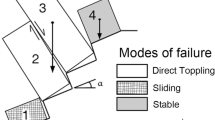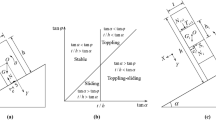Abstract
This paper investigates the importance of kinematic release mechanisms on planar translational slope failure using three-dimensional distinct element codes. The importance of the dip and dip direction of the rear, basal and lateral release surfaces and their influence on failure mechanism, dilation, and the development of step-path failures is illustrated. The three-dimensional block shape and volume of the unstable rock masses simulated with the different discontinuity set geometries are characterized. Two assumed three-dimensional slope models are investigated in order to assess the importance of varying kinematic confinement/release mechanisms. These two assumed boundary conditions are shown to be critical in the development of asymmetrical rock mass deformation patterns. Scale effects due to the block size and discontinuity persistence are shown to control the calculated displacement and failure mechanisms. The numerical modelling results are also demonstrated to be sensitive to the assumed normal and shear stiffness of the discontinuities. The influence of the factors investigated on the failure of a single rock block versus a rock mass are compared and discussed.












Similar content being viewed by others
References
Ashby J (1971) Sliding and toppling modes of failure in model and jointed rock slopes, M.Sc. thesis London University, Imperial College, 60 p
Aydan O, Shimizu Y, Ichikawa Y (1989) The effective failure modes and stability of slopes in rock mass with two discontinuity sets. Rock Mech Rock Eng 22:163–188
Bandis SC, Lumsden AC, Barton NR (1983) Fundamentals of rock joint deformation. Int J Rock Mech Min Sci Geomech Abstr 20(6):249–268
Bobet A, Einstein HH (1998) Fracture coalescence in rock-type material under uniaxial and biaxial compression. Int J Rock Mech Min Sci 35(7):863–888
Bray JW, Goodman RE (1981) The theory of base friction models. Int J Rock Mech Min Sci Geomech Abstr 18:453–468
Brideau M-A, Stead D (2009) The role of rear release surfaces, block size and lateral confinement on rock slope failure mechanisms. In: 62nd Canadian geotechnical conference and 10th joint groundwater CGS/IAH-CNC conference. Halifax, Nova Scotia, pp 489–496
Brideau M-A, Stead D (2010) Controls on block toppling using a 3-dimensional distinct element approach. Rock Mech Rock Eng 43(3):241–260
Brideau M-A, Stead D (2011) The influence of three-dimensional kinematic controls on rock slope stability. In: Sainsbury D, Hart R, Detournay C, Nelson M (eds) Proceedings of the 2nd international FLAC/DEM symposium, Melbourne, Australia, February 2011, pp 213–220
Brideau M-A, Yan M, Stead D (2009) The role of tectonic damage and brittle rock fracture in the development of large rock slope failures. Geomorphology 103(1):30–49
Brideau M-A, Sturzenegger M, Stead D, Jaboyedoff M, Lawrence M, Roberts NJ, Ward BC, Millard TH, Clague JJ (2011) Stability analysis of the 2007 Chehalis Lake landslide based on long-range terrestrial photogrammetry and airborne-LiDAR data. Landslides. doi:10.1007/s10346-011-0286-4
Cheng D, Liu H, Lium D, Cui Z (2010) 3D deformation study on anti-dip layered rock slopes. In: Williams AL, Pinches GM, Chin CY, McMorran TJ, Massey CI (eds) 11th Congress of the international association for engineering geology and the environment. CRC Press, Auckland, New Zealand, pp 2771–2778
Choquet P, Tanon DDB (1985) Nomograms for the assessment of toppling failure in rock slopes. In: 26th U.S. symposium on rock mechanics. Rapid City, South Dakota, Balkema, Rotterdam, pp 19–30
Corkum AG, Martin CD (2004) Analysis of a rock slide stabilized with a toe-berm: a case study in British Columbia, Canada. Int J Rock Mech Min Sci 41(7):1109–1121
Cundall PA (1988) Formulation of a three-dimensional distinct element model—part I: a scheme to detect and represent contacts in a system composed of many polyhedral blocks. Int J Rock Mech Min Sci Geomech Abstr 25(3):107–116
Eberhardt E, Stead D, Coggan JS (2004) Numerical analysis of initiation and progressive failure in natural rock slopes—the 1991 Randa Rockslide. Int J Rock Mech Min Sci 41(1):69–87
Einstein HH, Veneziano D, Baecher GB, O’Reilly KJ (1983) The effect of discontinuity persistence on rock slope stability. Int J Rock Mech Min Sci Geomech Abstr 20(5):227–236
Franz J (2009) An investigation of combined failure mechanisms in large scale open pit slopes. PhD thesis. University of New South Wales, Sydney Australia, 387 p
Franz J, Cai Y (2008) Investigation of slope failure mechanisms caused by large scale geological structures at the Cadia Hill Open Pit. In: Chen Z, Zhang J-M, Ho K, Wu F-Q, Li Z-K (eds) Proceedings of the 10th international symposium on landslides and engineered slopes. CRC Press, pp 1165–1171
Galic D, Glaser SD, Goodman RE (2008) Calculating the shear strength of a sliding asymmetric block under varying degrees of lateral constraint. Int J Rock Mech Min Sci 45(8):1287–1305
Goodman RE (2003) A hierarchy of rock slope failure modes. Felsbau 21(2):8–12
Goodman RE, Bray JW (1976) Toppling of rock slopes. In: Specialty conference on rock engineering for foundations and slopes. American Society of Civil Engineering, Boulder, Colorado, pp 201–234
Goodman RE, Kieffer DS (2000) Behaviour of rock in slopes. J Geotech Geoenviron Eng 126(8):675–684
Hammah RE, Yacoub T, Curran JH (2009) Variation of failure mechanisms of slopes in jointed rock masses with changing scale. In: Diederichs MS, Grasselli G (eds) Third Canada-U.S. rock mechanics symposium, Toronto, Canada, Paper 3956
Hart RD (1993) An introduction to distinct element modeling for rock engineering. In: Hudson JA, Brown ET, Fairhurst C, Hoek E (eds) Comprehensive rock engineering: principles, practice and projects. Pergamon, pp 245–261
Hart RD, Cundall PA, Lemos J (1988) Formulation of a three-dimensional distinct element model—part II. Mechanical calculations for motion and interaction of a system composed of many polyhedral blocks. Int J Rock Mech Min Sci Geomech Abstr 25(3):117–125
Hencher SR, Liao Q-H, Monaghan BG (1996) Modelling slope behaviour for open-pits. Trans Inst Min Metall Sect A Min Ind 105:A37–A47
Itasca (2008) 3DEC version 4.10, Itasca Consulting Group Inc. Minneapolis, Minnesota
Jennings JE (1970) A mathematical theory for the calculation of the stability in open cast mines. In: Proceedings of planning of open pit mines, Johannesburg, South Africa, pp 87–102
Kalenchuk KS, Diederichs MS, McKinnon S (2006) Characterizing block geometry in jointed rockmasses. Int J Rock Mech Min Sci 43(8):1212–1225
Kalenchuk KS, Hutchinson DJ, Diederichs MS (2009a) Influence of shear surface geometry on deformation processes in massive landslides. In: Diederichs MS, Grasselli G (eds) 3rd Canada-US rock mechanics symposium, Toronto, Canada, Paper 3974
Kalenchuk KS, Hutchinson DJ, Diederichs MS (2009b) Downie slide—interpretation of complex slope mechanics in a massive, slope moving, translational landslide, 62nd Canadian geotechnical conference, Halifax, Canada, pp 367–374
Kieffer DS (2003) Rotational instability of hard rock slopes. Felsbau 21(2):31–38
Kieffer DS (2006) Influence of cross jointing on block slump stability. In: 41st US symposium on rock mechanics: 50 year of rock mechanics—landmark and future challenges, Golden, Colorado, pp 6–1127
Kimber OG, Allison RJ, Cox NJ (1998) Mechanisms of failure and slope development in rock masses. Trans Inst Br Geograph 23(3):353–370
Kinakin D (2004) Occurrence and genesis of alpine linears due to gravitational deformation in south western British Columbia. M.Sc. Thesis, Simon Fraser University, Burnaby, BC, 174 p
Kulhawy FH (1975) Stress deformation properties of rock and rock discontinuities. Eng Geol 9(4):327–350
MacLaughlin MM, Sitar N (1996) Kinematics of sliding on a hinged failure surface. In: Aubertin M, Mitri H (eds) Second North American rock mechanics symposium. Balkema, Rotterdam, pp 2025–2030
Nichol SL, Hungr O, Evans SG (2002) Large-scale brittle and ductile toppling of rock slopes. Can Geotech J 39:773–788
Palassi M, Ashitiani M (2008) Comparison of 2D and 3D distinct element analyses in stability of convex jointed rock slopes. In: 61st Canadian geotechnical conference and 9th joint CGS/IAH-CNC groundwater conference. Canadian geotechnical society, Edmonton, AB, pp 640–645
Rosso RS (1976) A comparison of joint stiffness measurements in direct shear, triaxial compression, and in situ. Int J Rock Mech Min Sci Geomech Abstr 13(3):167–172
Sagaseta C (1986) On the modes of instability of a rigid block on an inclined plane. Rock Mech Rock Eng 19:261–266
Sitar N, MacLaughlin MM, Doolin DM (2005) Influence of kinematics on landslide mobility and failure mode. J Geotech Geoenviron Eng 131(6):716–728
Sturzenegge M, Stead D (2012) The Palliser rockslide, Canadian rocky mountains: characterization and modeling of a stepped failure surface. Geomorphology 138(1):145–161
Wyllie DC, Mah C (2004) Rock slope engineering: civil and mining, 4th edn. Spon Press, New York
Yan M (2008) Numerical modelling of brittle fracture and step-path failure: from laboratory to rock slope scale. PhD thesis. Simon Fraser University, Burnaby, Canada, 308 p
Yan M, Stead D, Sturzenegger M (2007a) Step-path characterization in rock slopes: an integrated numerical modeling-digital imaging approach. In: Proceeding of the 11th congress of the international society for rock mechanics. Lisbon, Portugal, pp 693–696
Yan M, Elmo D, Stead D (2007) Characterization of step-path failure mechanisms: a combined numerical modelling-field based study. In: Eberhardt, E, Stead D, Morrison T (eds) 1st Canada-U.S. rock mechanics symposium. Vancouver, BC, pp 493–501
Yoon WS, Jeong UJ, Kim JH (2002) Kinematic analysis for sliding failure of multi-faced rock slopes. Eng Geol 67:51–61
Acknowledgments
The authors would like to acknowledge funding from NSERC, Simon Fraser University Graduate Scholarship, and the FRBC Resource Geoscience and Geotechnics Endowment Fund. The authors would also like to thank D. vanZeyl for his assistance with the 3DEC plots.
Author information
Authors and Affiliations
Corresponding author
Rights and permissions
About this article
Cite this article
Brideau, MA., Stead, D. Evaluating Kinematic Controls on Planar Translational Slope Failure Mechanisms Using Three-Dimensional Distinct Element Modelling. Geotech Geol Eng 30, 991–1011 (2012). https://doi.org/10.1007/s10706-012-9522-5
Received:
Accepted:
Published:
Issue Date:
DOI: https://doi.org/10.1007/s10706-012-9522-5




